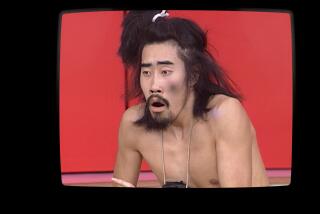Hiroshima Survivor and Nuclear Scientist Team Up : Technology: The two men are joining forces to pave the information highway. They have created a device to help the visually impaired get around. But funding is a problem.
LAFAYETTE, Calif. — At age 7, Thomas Takashi Tanemori emerged from the ashes of Hiroshima to begin life as an orphan.
As an angry young man of 18, he immigrated to the United States, fired by dreams of prosperity--and revenge.
But at 56, almost blind from a deteriorating eye condition, Tanemori has a new goal--developing a device to help the visually impaired get around.
His partner?
A scientist at Lawrence Livermore National Laboratory, one of the nation’s premier Cold War nuclear weapons designers.
“I feel as though I have made a full circle,” said Tanemori. “Once they were the enemy, in a sense . . . but now we are working together.”
Tom Moore, the scientist working with Tanemori, is equally impressed by the twisting currents that have shaped Tanemori’s journey.
“How can you miss that irony? I just sort of get amazed at the serendipity,” he said.
The story of Tanemori’s early involvement with U.S. forces began in August, 1945, with the detonation of the atomic bombs that helped bring World War II to a close in the Pacific.
He remembers a brilliant flash, then being dug out of the rubble of his elementary school by a passing soldier. Miraculously, he was reunited with his father on the banks of a river teeming with the dead and injured.
But the reunion was brief. His father wasted away from radiation poisoning over the next 40 days. Tanemori himself was near death.
“I was seven-tenths of a mile from the (blast),” he said. “I was considered dead, and as a matter of fact they already made a cremation box. But I survived.”
Years later he came to California, bent on somehow making Americans feel the “pain, loneliness, anger, as I have done.”
In the meantime, he hoped to make a fortune in the land of “money trees and streets paved with gold.”
Instead, he ended up at a migrant camp, where he fell ill and was shuttled from hospital to hospital by doctors who thought he had radiation poisoning.
*
In fact, he had food poisoning.
From there, Tanemori’s fortunes looked up. He was taken in by a San Francisco family who encouraged him to go to college. It was an education he put to diverse uses, working at various times as a schoolteacher, Baptist minister and cultural consultant.
Along the way his anger at the United States evaporated.
In 1974, he became a U.S. citizen, one of his proudest accomplishments. In 1987 he discovered he had retinitis pigmentosa, which has all but robbed him of his sight.
It’s an inherited condition, but no one else in his family had it, said Tanemori. He suspects the atomic blast may be to blame.
For eight years he struggled with “agony, soul-searching, anger, depression.” But then came a day when he decided “going blind will not end my life.”
He contacted his congressman, Rep. Bill Baker (R-Danville), and, through him, met Moore.
At that point, Tanemori already had proposed a system to save blind people the indignity of stumbling down unfamiliar streets, a tape-recorded guide to cities similar to self-guided tours at many museums. Moore, the lab’s deputy division leader for computers and communications engineering, refined it. His idea: Place electronic tags on objects such as a street corner, a sign or a bus. A device carried by the user would read and decipher the tags.
For instance, “you might get instructional directions, like, ‘The restrooms are 50 feet on the right.’ You can get all manner of messages.”
*
The devices could help the visually or hearing-impaired or “just people who get lost easily,” he said. It could operate in different languages to aid tourists or be coded with information emergency teams need.
Moore estimates he could have a prototype available for field tests in less than a year. But funding is a problem.
“We’ve come to the conclusion that this is not a technological issue,” Moore explained. “It is finding a sufficient number of applications and the political will to go in and solve it.”
Moore, who works on the project mostly in his spare time, is devising strategies to find the approximately $3 million to $5 million it will take to pay for a three- to five-year development program.
His is not the only entry in the smart environment field.
In San Francisco, more than 90 “Talking Signs,” were recently demonstrated in the Powell Street Bay Area Rapid Transit station.
Those signs, developed by the Smith-Kettlewell Institute for the Blind, work by beaming signals in infrared light that trigger voice messages on a hand-held receiver.
*
Moore hopes to coordinate with other researchers. He points out that the lab has experience working in partnership with companies who otherwise are fierce competitors and could help set standards for the burgeoning industry.
Tanemori, meanwhile, eagerly awaits the next chapter in an eventful life. “This is a great new beginning,” he said.
More to Read
Sign up for Essential California
The most important California stories and recommendations in your inbox every morning.
You may occasionally receive promotional content from the Los Angeles Times.










